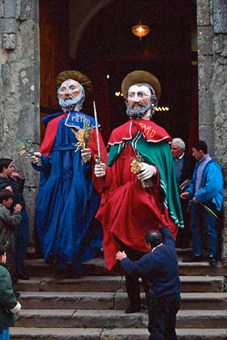Processional and parading Giants
 The ‘processional’ and ‘parading’ Giants originally were superhuman size mannequins that “walked” on stilts. They consisted of a skeleton of wicker and wood dressed in clothes made of fabric, that march and dance, being “carried” or “worn” by one or more people, in religious processions, festive events and secular parades (like the grandiose ceremonies organized to greet the entry of kings and princes in the most important European cities). From the late Middle Ages, the Giants took on a progressively more robust and sophisticated appearance, and thus a more stable posture. to the point that today, in some cases, we see them placed on carts and mobile platforms, designed to support the weight gained due to the use of different and heavier materials (iron, aluminum, plaster and papier-mâché).
The ‘processional’ and ‘parading’ Giants originally were superhuman size mannequins that “walked” on stilts. They consisted of a skeleton of wicker and wood dressed in clothes made of fabric, that march and dance, being “carried” or “worn” by one or more people, in religious processions, festive events and secular parades (like the grandiose ceremonies organized to greet the entry of kings and princes in the most important European cities). From the late Middle Ages, the Giants took on a progressively more robust and sophisticated appearance, and thus a more stable posture. to the point that today, in some cases, we see them placed on carts and mobile platforms, designed to support the weight gained due to the use of different and heavier materials (iron, aluminum, plaster and papier-mâché).
The first ritual giants of which we have records date back to the last centuries of the Middle Ages. In the Renaissance began the first major transformation of the landscape of European ‘giants’, which came to full fruition during the Baroque era. The features and profiles of processional and parading giants have changed continuously, from the religious scenography in which they were conceived they have passed onto a civic and symbolic universe and, over time, in contexts increasingly devoid of their original history and symbolic grammars, reaching more restricted smaller folkloristic and popular spheres. This path, however, did not always go in one direction. Sometimes, in fact, the character and identity of the original giants was retrieved (being reinvented). All these metamorphoses have ensured a surprising longevity to the festive giants, due to the vagueness of their symbolic profile and their fragility. Sometimes, the giant understood as an object has survived tenaciously despite the disappearance of meaning (which is often difficult to track down) conferred on it by its original builders and spectators; other times, on the contrary, its meaning survived the physical death of the giant, which incarnated in another colossal figure. A consequence of this is the current existence of the Giants, in various regions of Europe, equipped with multiple identities, which all hearken back to legendary tales, which only rarely are authoritative. Indeed, in most cases, they are incredible and coarsely assembled. The work of scholars and intellectuals, over time, has accumulated a repertoire of possible explanations, which are proposed, not without altering common sense.
